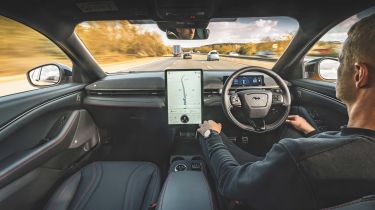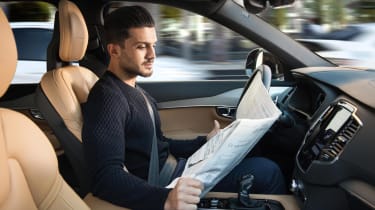Self-driving cars: all you need to know
We’ve been told that they’re the future and, at last, legislation appears to be catching up. But when will self-driving cars be a reality? Read on...

Self-driving cars were, in fairly recent history, considered the stuff of cartoons and sci-fi films. Today, though, a huge number of cars on the market have at least some 'autonomous driving' capability. But what exactly does this mean for you?
Cars have featured autonomous technology for a number of years, whether that be parking assistants or adaptive cruise control. However, a fully independent, self-driving car is yet to leap over the many legislative and technological hurdles. The increased resolution and affordability of radars, cameras, and even lasers have brought the fully autonomous car closer, and these are already being used in systems like lane keep assist and collision avoidance.
Essentially the same technology sired the autonomous emergency braking systems fitted to many new cars today. Instead of just detecting and following the car in front, here the radar sensors are used to identify obstacles ahead and instruct the car to brake (and steer in some cases) to avoid them.
So the technology has long existed to allow a car to automatically cruise in traffic and then come to a safe stop if it needs to. The next step is to allow cars to steer themselves, as well as accelerate, stop and – using satellite technology, high-resolution mapping and networked communication – give them the brains to find their way around. Such fully autonomous cars, requiring nothing from the driver other than a command to set off, are technically feasible right now.
In North America, you can order any new Tesla with ‘Full Self-Driving’ capabilities. It’s the closest many of us have seen to the ideal, point-to-point autonomous experience, with its ability to navigate both motorways and city streets, read traffic signs and park upon reaching its destination. However, Tesla is keen to point out that this is not a fully autonomous system, still requiring the driver’s constant supervision and having reduced capabilities during heavy rain or fog. This system is yet to be legally permitted in the UK, so we have to make do with Tesla’s less advanced (but still very useful) Autopilot system. However, this could soon be about to change.
Can I buy a self-driving car in the UK?
Vehicles with semi-autonomous capabilities are already on sale in the UK, but don’t visit your dealership expecting to be chauffeured out by a self-driving car. Most systems, such as Tesla's Autopilot and Volvo's Pilot Assist, require you to keep your hands on the wheel, even though the system can automatically accelerate, brake and even steer the car.
The Autopilot system, available in the UK on all new Teslas, can take almost all of the effort out of motorway driving – all you need to do is provide guidance. As long as your hands are on the wheel, Autopilot will cruise, brake and even change lanes on your behalf – a flick of the indicator tells the car you intend to overtake. For drivers, this can reduce tiredness, although some may find it challenging to hand over control almost entirely, whilst still having to remain vigilant.
In April 2023, the UK Government permitted the first ‘hands-free’ semi-autonomous driving technology, with Ford’s BlueCruise system, available for the electric Mustang Mach-E. Whilst the driver can remove their hands from the steering wheel, an internal monitoring system keeps watch to ensure that the driver is focused on the road ahead at all times. The system is also legally restricted to motorways for now.
Although many commuters would like to think a car that can take them to the office while they nap or work is just around the corner, in reality, we suspect that these systems won’t be available for several years.
What does the law say?

You may have seen an advertisement for a self-driving car for sale and thought that the technology was already here. The systems to allow full, unrestricted self-driving may technically exist but none are legal for UK roads at the moment. Accountability has been a sticking issue for lawmakers – if a self-driving car crashes, who’s at fault?
It appears that this legal puzzle may soon be solved. During the King’s Speech in November 2023, the UK Government announced plans to introduce the Automated Vehicles Bill, in which it outlined plans to permit fully self-driving cars on our roads in the near future. The Bill states that the legal responsibility for the safe operation of the vehicle would rest on the ‘driver’, be that a human being or a self-driving system. It aims to provide immunity to the user of an autonomous vehicle in the unlikely event that the car were to crash.
This new legislation also states that the vehicle must follow all road traffic rules without any monitoring or intervention by the occupant to qualify as ‘self-driving’. A raft of new safety standards will be introduced and the Department for Transport will be responsible for ensuring that all new self-driving cars comply before arriving on our shores.
Apportioning responsibility, especially as we see a mix of autonomous driving and human driving, is an area insurance firms are still fleshing out, but they are getting closer, and this new legislation will provide some much-needed clarity. The most likely outcome to all this will be a slow introduction that both the public, police, and insurance brokers can understand.
How do autonomous cars work?
We’ll try to explain without resorting to language more commonly found in the faculty room of the physics department of the Massachusetts Institute of Technology.
Essentially, a lot of the necessary systems already exist. The biggest challenge is bringing them together to operate harmoniously. For example, adaptive cruise control – a feature that’s becoming more and more common in cars – uses radar (essentially very powerful parking sensors) to determine the distance to the vehicle in front. You select a safe distance and the system manipulates the car’s engine and brakes to maintain it.

There’s also blind-spot monitoring (which detects cars sitting in your blind spot on the motorway), detailed satellite navigation, parking sensors, road-sign-recognition cameras, automatic gearboxes and electrically assisted steering.
All of these systems individually control one aspect of the car. When they’re brought together with an array of extra cameras, sensors and, of course, computing power, the car can essentially ‘see’ all around it and what the driver is doing and where their attention is focused. The car’s ‘brain’ then uses this information to stop, go, steer and react to its surroundings.
Self driving cars: Pros and cons
Pros
Car manufacturers are convinced that self-driving will offer endless benefits to drivers, freeing them from the controls and allowing drivers time to work, consume media or shop online. Other manufacturers have been more cautious in their wording, but are still optimistic towards self-driving cars. Volvo sees self-driving as an integral part of its desire to reduce death or serious injury in or by one of its vehicles to zero.
One of the clearest benefits is for efficiency, a win-win for car companies and drivers. Automated systems don’t have emotions, and they don’t react to hearing loud fast music, or smooth talk radio. Instead, they drive for the highest efficiency, whereas humans can brake too sharply and accelerate harshly, an autonomous system would maximise efficiency at all times that it is safe to do so. So it will be cheaper to run, and manufacturers will score better real-world efficiency scores.
It also means that self-driving systems have the potential to be much safer than human drivers. The Institute for Engineering and Technology estimates that for every 10,000 driving errors made by humans, a self-driving system would make just one. This is still to be proven in the real world, however, a possible reduction in collisions on the road can only be seen as a benefit.
Cons
Many motorists worry about being disconnected from a machine that is travelling at a high rate of speed. Car manufacturers may see humans as the weak link, but at the moment, humans are still often better able to make judgements in very complex situations than a computer.
There is also an element of trust, rightly or wrongly, humans believe in their own abilities, handing these over to a machine won’t be palatable for everyone.
Manufacturers are also starting to see some challenges with setting themselves apart in a world of autonomous cars. Why buy a sporty car if you won’t drive it, and how do BMW and Mercedes differentiate themselves from Skoda or Ford when they are essentially selling a personal taxi service?
The free time we gain from not being stuck on our commute may just become more time to work, rather than playing games or reading a book. You only have to look at rush hour on a train to see more people opening up work laptops or sending work emails on their phone, rather than relaxing, watching a film, or having a nap.
Finally, there are the enthusiasts that will sorely miss their time driving. However, when the Ford Model T ushered in mass-produced cars, horse riders started riding for fun rather than transportation. We may see fewer cars being enjoyed on the road, but racetracks, and the cars that frequent them, from humble Caterhams to Porsches and Ferraris aren’t going anywhere.
If you want to read about more motoring innovations, check out our guide to adaptive dampers or regenerative braking technology...
Most Popular
Tips & advice

Car dashboard warning lights: what does each symbol mean?

Electric car charging stations: public networks, charger types, apps and maps







